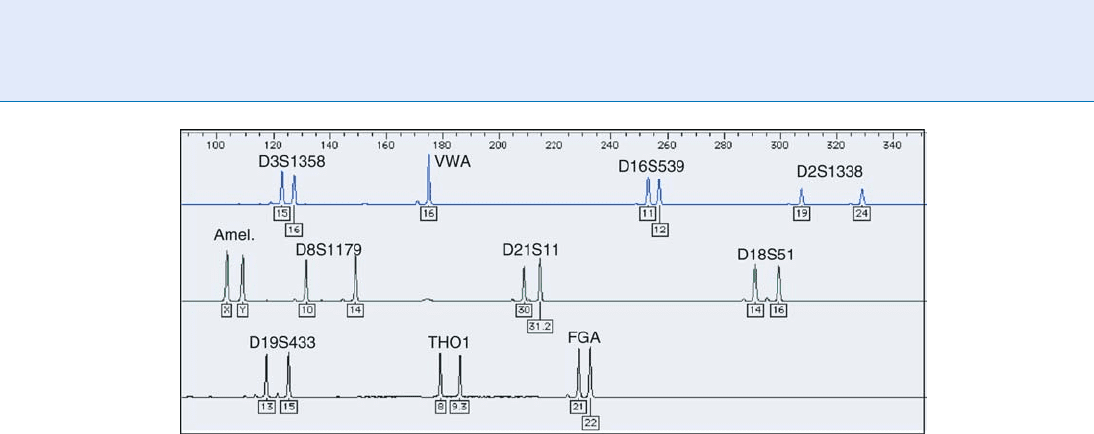Li S.Z., Jain A.K. (eds.) Encyclopedia of Biometrics
Подождите немного. Документ загружается.


impressions and footprint casts taken from a suspect.
Similarly, a link to footwear matched to a crime scene
can be determined by comparing the insoles of the
crime scene footwear to footwear seized from a sus-
pect, or to inked impressions and casts taken from
a suspect.
Introduction
Barefoot morphology comparison refers to the exami-
nation of the weight-bearing areas on the bottom of a
human foot, when ridge detail is not present, to estab-
lish a link between the bare foot of an individual and
a footprint impression found at a crime scene [1–3].
In the case of footwear linked to a crime scene, com-
parison can be made to shoes seized from a suspect, or
to inked impressions or casts taken from a suspect.
Research has indicated that the shapes of footprints
are sufficiently variable to make it possible to include
(as having possibly made the impression) or exclude
(as definitely not having made the impression) a sus-
pect as being the person who created a particular
footprint at a crime scene [3]. As an example, Fig. 1
show barefoot impressions taken from identical twins,
illustrating that even twins can be differentiated based
on their footprints.
When a crime scene is being examined, it is com-
mon to find footprints that might be those of the
perpetrator of the crime. If ridge detail is developed
in a barefoot impression, the comparison to a suspect’s
foot can be carried out in exactly the same fashion as a
fingerprint comparison [4, 5]. If enough ridge detail,
with sufficient clarity, is available for comparison, a
positive identification may be forthcoming. However,
if the barefoot impression is smudged or unclear for
any other reason, or if it is a socked impression,
then recourse can be made to barefoot morphology
comparison.
Similarly, when a shoe has been positively identi-
fied back to a crime scene, and no suspect has been
found in possession of the footwear in question, re-
course can again be made to barefoot morphology
comparison. This can be accomplished by comparing
the impressions on the insole inside the crime scene
shoe to the impressions inside a similar shoe worn by
the suspect, or to inked impressions and casts seized
from the suspect.
The comparison itself is similar to a toolmark or
tire track comparison, where the foot has acted like a
tool or a tire in creating an imp ression at the
crime scene. The shapes of various parts of the foot
are com pared to se e if there is correspondence
between the crime scene impression and the suspect
exemplars. In a footwe ar examp le, the imp ression to
be compared has been made on the insole of the
identified footwear.
Background
Although footprints in gen eral look quite similar,
it has long been assumed that careful examination of
barefoot impressions could be used to differentiate
between people. Historically, in various societies,
trackers have been trained to be able to pick up some-
one’s trail and to follow the person based on their
footprints [3].
Footprint evidence was presented in court as early
as the late nineteenth century, when a criminal w as
convicted in 1888 based on his footprint. Other cases
have since been documented in the forensic literature,
mainly from Europe and North America [6]. Much of
this early casework was based on the assumption that
Forensic Barefoot Comparisons. Figure 1 Barefoot
impressions taken from identical twins, illustrating the
variability of footprints, even for twins.
570
F
Forensic Barefoot Comparisons

footprints were unique to the individual, without
many studies to support this hypothesis.
Whenever a new means of including or excluding
suspects is being introduced in court, the basis for the
comparison must be justified. Some early work on foot-
print variability was carried out in India [7], while in
North America, Dr. Louise Robbins, an anthropologist,
carried out studies on the individuality of footprints in
the 1970s [8 ]. In the 1980s, the Federal Bureau of
Investigation (FBI) collected and compared footp rint
impressions from hundreds of volunteers to show how
variable barefoot impressions might be [9, 10].
The Royal Canadian Mounted Police (RCMP)
began research in this area in the 1990s [11]. Inked
barefoot impressions were collected from thousands of
volunteers for entry into a computerized database. As
each footprint was measured and entered, it was com-
pared with previous impressions in the database to
ensure that another foot did not share the same mea-
surements. A statistical analysis of the impressions was
carried out to illustrate how variable barefoot impres-
sions are [12]. Even with a limited number of samples
and measurements, probabilities on the order of 1 in
a billion were achieved.
Collecting Evidence [3]
When a bare or socked foot impression is found at a
crime scene, the investigator must document the evi-
dence correctly. Photographs, with a scale included,
should be taken. If required, barefoot impressions can
sometimes be enhanced in situ using fingerprint pow-
der or chemical techniques, especially for impressions
in blood. Impressions can then be lifted, or, depending
on the surface, the entire impression can be removed
from the scene. All of this evidence will have to be sent
to the expert who is doing the final barefoot morphol-
ogy comparison.
Similarly, when footwear impressions are found,
they should be thoroughly documented. Again, en-
hancement techniques can be used to make the
impressions more visible. If accidental characteristics
are noted, there is the possibility of positively linking a
shoe to the impression found at the crime scene.
If a suspect is arrested, his feet and his foot impres-
sions must be well-documented. Several photographs,
including a scale, should be taken of the feet to ensure
that the tops, sides, and bottoms are all recorded. Foam
impressions should be taken for la ter casting. Inked
standing and walking impressions should also be
obtained. Standing and walking impressions should
also be obtained with the suspect wearing a pair of
socks.
If the case involves footwear impressions, attempts
should be made to seize similar footwear from the
suspect. The best comparison would be of a shoe
insole with another shoe insole. However, the feet of
the suspect should also always be recorded in the
same manner as described above.
The Comparison Process [3]
Barefoot morphology comparison should only be
undertaken by an adequately-trained specialist. The
RCMP has conducted barefoot comparison courses in
North America and Europe, training forensic specia-
lists from several countries. A group of doctors has
recently formed a forensic podiatry sub-committee
within the Internat ional Association for Identification
(IAI), currently establishing its own criteria for train-
ing and standards.
As in any other physical comparison, class charac-
teristics are compared first. The overall size of the foot
and the number of toes making contact with the
ground would be considered class characteristics, and
can be used to quickly eliminate a suspect foot.
The shape and placement of the toes, the shape
of the
▶ metatarsal ridge, the length and width of the
arch, and the contour of the heel can be examined and
compared (see Fig. 2). Any unexplained feature can
be used to eliminate a suspect, while correspondence
of features means that the suspect foot remains
included as a possible source of the crime scene im-
pression. Some examiners will make positive iden-
tifications based on foot morphology [13 ], while
others will only go as far as a strong likelihood that
the same foot made both the crime scene print and the
exemplar [3]. Because the uniqueness of barefoot
impressions has not been proven, and crime scene
and inked impressions are not exactly reproducible,
current RCMP policy advises examiners against
making positive identifications. Positive identifications
may be possible when flexion creases, marks, and scars
are visible [14].
When the impression is three-dimens ional, like
a footprint in mud, it is important to try to obtain a
Forensic Barefoot Comparisons
F
571
F

three-dimensional replica of the suspect’s foot for
comparison. The use of foam impression material
and dental casting material should be considered.
In the case of footwear that has been positively
identified back to the crime scene, and where footwear
has be en seized from the suspect, the outer areas of the
shoe can be examined to confirm that wear on the
shoes is similar. The barefoot impressions made on
the insoles can then be compared in much the same
fashion as the barefoot comparisons described above.
The inside uppers of the footwear can also be exam-
ined to look for agreement or disagreement of wear
and damage. If footwear cannot be seized from the
suspect, then the examiner must make-do with inked
impressions and casts of the suspect’s bare feet, bearing
in mind the changes in morphology caused by the foot
being constricted in the shoe.
In Court
Barefoot morphology comparison is not yet a rou-
tinely-accepted forensic technique. As such, it is still
vigorously challenged when it is presented in court.
In Canada, the testimony has been successfully
defended in Mohan and Voir Dire hearings [15],
(R v Dimitrov was overturned because the jury
put too much emphasis on ‘‘could have been’’ testimo-
ny, and not because of the technique itself) while in
the US it has withstood the scrutiny of ‘‘Rule 702,’’
Frye, and Daubert challenges. An early case that was
sent back on appeal when the judge felt that not
enough background research had been done has been
successfully re-tried in light of more recent published
research. In essence, the courts have started to
recognize the scientific foundation upon which the
evidence is based.
Besides Canada and the United States, barefoot
comparison testimony has been tendered in several
countries around the world. In Israel, barefoot
morpholog y comparison testimony was appealed
all the way up to the highest court, and upheld.
As the technique becomes more accepted, prosecu-
tors and defense lawyers w ill soon start to look for
opportunities where this type of evidence might be
useful.
Conclusion
Barefoot morphology comparison refers to the com-
parison of the weight-bearing areas of feet in an effort
to include or exclude a suspect as being linked to a
crime scene. Background research has established the
variability of barefoot impressions, justifying their use
in a forensic context. Crime scene investigators should
be aware of this technique and should always be look-
ing for suitable evidence of this kind.
Related Entries
▶ Earprints
▶ Fingerprints
References
1. Bodziak, W.J.: Footwear Impression Evidence, pp. 381–411. CRC
Press, Boca Raton, FL (2000)
Forensic Barefoot Comparisons. Figure 2 Comparing the toes and the contour of the metatarsal ridge.
572
F
Forensic Barefoot Comparisons

2. Kennedy, R.B.: Bare footprint marks. In: Siegel, J.A., Saukko, P.J.,
Knupfer, G.C. (eds.) Encyclopedia of Forensic Sciences,
pp. 1189–1195. Academic Press, London (2000)
3. Kennedy, R.B., Yamashita, A.B.: Barefoot morphology compar-
isons: a summary. J. Forensic Ident. 57(3), 383–413 (2007)
4. Lemieux, M.: Histoire de Pied/a foot story. Identif. Can. 25(4),
16–17 (2002)
5. Watkins, D., Brown, K.C.: The case of the toe print. J. Forensic
Ident. 57(6), 870–873 (2007)
6. McCafferty, J.D.: The shoe fits. The Police J. 28(2), 135–139
(1955)
7. Puri, D.K.S.: Footprints. Int. Police Rev. 187, 106–111 (1965)
8. Robbins, L.M.: The individuality of human footprints. J. Forensic
Sci. 23(4), 778–785 (1978)
9. Lovejoy, O.C.: Methods of Footprint Analysis. Seminar in Foot-
print and Shoeprint Identification. Federal Bureau of Investiga-
tion, 29 April 1984
10. Bodziak, W.J., Monson, K.L.: Discrimination of individuals by
their footprints. Paper presented at 11th meeting of Internation-
al Association of Forensic Sciences, Vancouver, BC (1987)
11. Kennedy, R.B.: Uniqueness of bare feet and its use as a possible
means of identification. Forensic Sci. Int. 82(1), 81–87 (1996)
12. Kennedy, R.B., Chen, S., Pressman, I.S., Yamashita, A.B.,
Pressman, A.E.: A large-scale statistical analysis of barefoot
impressions. J. Forensic Sci. 50(5), 1071–1080 (2005)
13. DiMaggio, J.A.: The Foot as a Forensic Tool. Paper presented at
the 55th annual meeting of the American Academy of Forensic
Sciences, Chicago, IL (2003)
14. Massey, S.L.: Persistence of creases of the foot and their value for
forensic identification purposes. J. Forensic Ident. 54(3),
296–315 (2004)
15. Richard, C.: Case law: [2002] Ontario superior court R. V.
Arcuri. Identif. Can. 25(4), 18–20 (2002)
Forensic DNA Evidence
T. HICKS,R.COQUOZ
Institut de police scientifique, Ecole des sciences
criminelles, Lausanne, Switzerland
Synonyms
DNA analysis; DNA profiling; DNA typing
Definition
Deoxyribonucleic acid (DNA) is a large molecule present
in all living cells (e.g., animals, plants, viruses). As a tape
allows the storage of a recording, DNA allows the storage
of genetic information. It consists of two long chains of
nucleotides twisted in a double helix. There are four types
of nucleotides designed by the name of their bases:
Adenine (A), Guanine (G), Cytosine (C) and Thymine
(T). The genetic information is encoded in the sequence
of nucleotides of the DNA molecule. Part of its name
originates from its localization in the nuclei of the cell.
However, the acronym is also used for
▶ mitochondrial
DNA (mtDNA), which is the DNA present in the
mitochondria of the cells. It is transmitted only by
the mother.
Introduction
Although DNA profiling has high discriminating
power and can help establishing the biological identity
of a person, it is not used as a biometric yet. Indeed, the
results of the analysis are not immediate (nor yet
amenable to full automation), the cost of analysis is
high, and there are contamination and transfer issues.
Moreover, as parents transmit biological material
to their children, DNA can be intrusive and reveal
unknown family relationships.
Most of the text that follows is based on [1].
Another standard text in English is [2].
DNA: Basic Concepts
Each human cell contains biological information; each
of the cells thus contains the same DNA. As DNA is
a very long molecule (three billion base pairs), it is
organised into 23 small bundles: the chromosomes.
Each child receives two DNA: one from the mother
and one from the father. Each person (and each cell
from this person) has thus two copies of each chromo-
some, one from the mother and one from the father,
giving a total of 46 chromosomes. They are numbered
in pairs from 1 to 22, the 23rd pair being the sex
chromosomes X and Y. On each of the chromosomes,
there are genes (i.e., a zone where the DNA codes how
to make a protein). The number of genes is estimated
to be around 20,000–25,000. When reading DNA from
one extreme to the other, one will encounter a code
‘‘START’’ to indicate that one can read from here how
to make a given protein, and a code ‘‘STOP’’ to indi-
cate that this is the end of the genetic information
necessary for that protein. The code for the following
protein does not begin immediately after the ‘‘STOP’’
Forensic DNA Evidence
F
573
F

message and there are usually several thousands
nucleotides in between that do not code genetic infor-
mation. These are called noncoding DNA or junk DNA
and represent 98% of the genetic material. The geo-
graphical distribution of the genes and the noncoding
DNA is in principle identical across all individuals in a
given species.
A geographical nomenclature has been derived to
designate a given localization on the DNA strand of
human chromosomes: the locus (pl. loci). For each
locus, one copy is received from the father and one
copy from the mother. These two copies are called
alleles: therefore for each locus, a person will have
two alleles. The set of alleles owned by a person for a
locus is called his/her genotype. If the alleles transmit-
ted by the father and the mother are the same, the
individual is homozygote for this locus. If the two
alleles transmitted are different, then the individual
will be heterozygote at this locus. The loci are symbo-
lized by a four-digit code, that is particularly useful for
noncoding DNA. The first letter of the code is D (for
DNA), the second is the chromosome number (1, ...,
22, X, Y), the third element indicates the sequence type
(S: a unique sequence; Z a sequence that has several
copies, at different localizations, on the same chromo-
some; F a sequence that is part of a family with similar
sequences that are encountered on several chromo-
somes); the last digits are a unique number that gener-
ally correspond to the order in which the sequences
were discovered. As an example, the locus D18S51 is a
DNA region on chromosome 18, with the serial num-
ber 51. This locus is commonly used in forensics be-
cause of its polymorphism and is present in different
commercial kits (e.g., SGMplus ABI; Powerplex 16
Promega).
Since DNA is stable over the lifetime of an individ-
ual, and is reasonably resistant to chemical degra-
dation, it is a good candidate for use in forensic
science. One must further find a sensitive and not
too expensive technique that enables the analysis of
parts of the DNA that vary between individuals: the
genetic markers. These markers should show as much
as polymorphism as possible. There are two types of
polymorphisms: sequence polymorphism (the nature
of the nucleotides themselves differ from individual
to individual, e.g., mtDNA, SNPs) and length polymor-
phism (the difference between individuals is based
on the length of a given repetitive sequence of nucleo-
tides, e.g., STR).
In 1985, thanks to the discovery of repetitive
sequences, Sir Alec Jeffreys first applied the analysis
of DNA to forensic science. As discussed previously,
there are coding and non coding DNA. The repetitive
sequences are zones in the DNA, where noncoding
DNA seems to stutter. The human DNA has a very
large number of different repetitive sequences (30% of
the genome) and the length of the repetitive sequences
varies between individuals. If the length of the repeti-
tive sequence is larger than six nucleotides, one
speaks of VNTR (Variable Number Tandem Repeats,
Nakamura). If it is equal or smaller to six, one will speak
of STR (Short Tandem Repeat). STRs have also
been named microsatellites and VNTRs minisatellites.
Nowadays, STRs are the standard targets of the routine
analysis of forensic samples. Companies offer different
type of kits allowing the analysis of several STRs at
the same time (multiplex STR analysis). An example
of some kits available is given below:
Forensic DNA Analysis
Before analysis, one has to sample the DNA on the
crime scene and to sample the individual. As genetic
information is theoretically the same in every cell,
saliva is generally used for the later. On crime scenes,
chemical tests to detect saliva, sperm, or blood can be
used to help in finding the invisible stains. If a stain is
detected, the object is either cut, or swabbed. As, it is
possible to detect very low levels of DNA, it is highly
recommended to wear gloves and a face mask when
collecting DNA.
Once DNA has been collected, it will be extracted,
purified, and quantified. Because there is often very
little material in forensic samples, the specific zones
of DNA that are the target of the analyses will be
first amplified using a technique called Polymerase
Chain Reaction (PCR ). PCR is often compared to a
DNA photocopier, where a given DNA segment is
copied a given number of times. First, the zone to
be amplified is delimited using two primers: one is
placed at the beginning of the sequence and one at
the end. During the copying cycles of the PCR pro-
cess, copies of the original DNA zone will be produced.
After one cycle, there will be the original DNA and
one copy; after two cycles, there will be 2 more copies
and after 30 cycles there will be about a billion
copies (Fig. 1).
574
F
Forensic DNA Evidence

Multiplex STR Analysis
PCR can be used to copy simultaneously several DNA
fragments: one uses different primers, each corres-
ponding to the DNA zone that has to be copied. This
simultaneous amplification of different DNA zones
is called Multiplex PCR. The PCR products are ana-
lyzed using Capillary Electrophoresis. This technique
allows the separation of DNA fragments according to
their sizes while they travel through a thin capillary.
The large fragments move more slowly than small
fragments. A peak is displayed on the results’ graph,
when the detector at the end of the capillary detects
DNA molecules. The detector is able to differentiate
between up to five different dyes. The detector can
recognize STR alleles that have the same length but
are labeled with different dyes.
Theoretically, one can amplify dozens of different
fragments in one operation, which saves considerable
time. However, the design of multiplex STR analysis
kits is not straightforward: the numerous primers
involved must not interfere with each other; the set
of alleles of one STR must be recognized from the
alleles of the other STRs, either through the use of
different labeling dyes or because they are in different
size ranges. The different STR will be chosen if possible
on different chromosomes, so that the transmission of
the alleles from generation to generation can be con-
sidered independent.
PCR is unable to amplify efficiently large frag-
ments. It is thus not possible to increase indefinitely
the number of STR analyzed simultaneously with a
multiplex kit. The practical limit is around 15–20
STRs. An example of a profile obtained with Multiplex
STR analysis is shown below. The vast majority of
forensic DNA analyses done today is multiplex STR
analysis. It is the golden stand ard and fulfils most of
the needs of forensic DNA ana lysis.
Figure 2 shows the resu lt of an ana lysis performed
on an individual with the SGMplus kit.
Nonautosomal DNA
An autosome is a nonsex chromosome. Nonautosomal
DNA is a DNA that originates either from a sex chro-
mosome (i.e., X, Y), or from mitochondria (mtDNA).
Sex chromosome DNA is used to study the paternal
heritage: if there is no mutation, a son will have the
same Y chromosome than his brothers, his father, and
his paternal lineage; a daughter will have one of her X
chromosome identical to her father and her paternal
lineage. Mitochondrial DNA is used to study the ma-
ternal heritag e: a mother will transmit her mitochon-
drial DNA to her children, grandchildren, etc. These
markers are useful for parentage testing. Since there are
hundreds of copies of mtDNA per cell, mtDNA can
also be used when the trace is degraded or/and there
is very little nuclear DNA (e.g., hair without roots).
STRY may also be useful in rape cases, when the male
DNA of the agressor is not detected in the DNA profile
because of the presence of vast amounts of female DNA
in the mixture. When speaking of alleles observed for
Y chromosome STR or mtDNA and STRX, one speaks
of haplotype and not genotype, as a person owns
only one single allele.
Forensic DNA Evidence. Figure 1 From [1] representing the PCR Process.
Forensic DNA Evidence
F
575
F

Low Template DNA Analysis
In essence, PCR allows a sensitivity at the single molecule
level. However, for the standard DNA profiling, the
potential of PCR is curbed to avoid the stochastic effects
and contamination problems associated with an extreme
sensitivity. The sensitivity of standard DNA profiling is
thus adjusted to provide a DNA profile only when there
is DNA from at least 50 cells in the evidence material.
The concept of low template level analysis, or as previ-
ously known LCN (Low Copy Number), covers strate-
gies designed to go beyond this limit. The usual strategy
to reach such an extreme sensitivity is to increase the
number of copying cycles of the PCR (e.g., 34 cycles
instead of 28) [3]. Increasing sensitiv ity does not go
without caveats: artefacts arise with alleles dropping in
and dropping out. This added sensitivity also increases
the issue of contamination. The use LCN profiles
should induce very strict protocols to avoid contami-
nation on the scene and at the laborator y. It requires
cautious interpretation. In the Omagh Bombing,
the use of low template level profiles was challenged,
but was shown to be scientifically robust in the review
conducted by Professor Caddy, Dr Linacre, and
Dr Taylor [4].
SNPs and DNA Chips
SNPs (Single Nucleotide Polymorphisms) occur on
average every 1,200 nucleotides: that means that
depending on the individual the nucleotide in that
position will differ. In theory there might be four
variants (A, T, G, C) for the nucleotide; however,
because of the reality of the evolution process only
two variants are usually observed. The main caveat
of SNPs is their limited sequence polymorphism.
Multiplex analysis of a large number of SNPs can
however overcome this limitation. SNPs can be ana-
lyzed using miniaturized devices call ed DNA chips.
These are miniaturized systems allowing the analysis
of hundreds of SNPs. The disadvantages of SNPs
are their low polymorphism, and their very limited
capacity to handle DNA mixture cases. SNP analysis
certainly has good prospects for specific applica-
tions.
▶ Mitochondrial DNA polymorphisms are in
essence SNPs. SNP analysis has better chances of
success for highly degraded samples than STR ana-
lysis. Some specific SNPs have the capacity to pro-
vide morphological information (hair, eye colour, ...)
and Y chromosome SNPs should be able to pro-
vide useful ethnic information. Some companies
(e.g., 23andme; Decode genetics; ...) have star-
ted to offer to the public wide ranging SNP analyses
providing information on their ancestry, and pre-
dispositions to possible diseases (see, for example,
https://www .23andme.com/ or http://www.dec ode.com/).
Although their approach is controversial and not
forensically oriented, it is a good example of the
power of the SNP analysis technologies. Applications
of SNPs in context of forensic intelligence will
be briefly mentioned later.
Forensic DNA Evidence. Figure 2 Figure from [1] showing the result of an analysis performed on an individual with
the SGM plus hit. The raw data are decomposed by color: the labels below the peaks show the designation of the
detected alleles. She name above is the STR name. For most STRs, our individual has two peaks and is heterozygote
for these makers. For VWA, this person precents only one peak and is therefore homozygote for that particular marker.
576
F
Forensic DNA Evidence

DNA Sequencing
This method consists in reading the sequence of the
nucleotides of small pieces of DNA. It is the standard
tool for mtDNA analysis . More recent ‘‘whole genome
DNA sequencing’’ technologies are being developed.
They are massively paralle l sequen cing approaches
with the potential to provide the complete sequence
of an individual in a single process. Their potential for
forensic DNA analysis is not yet clear.
DNA used as Evidence and
Interpretation
DNA (human, animal or vegetal) can be used in diverse
areas: nature and species preservation, food control, miss-
ing persons, mass disaster identification, serious, and
volume crime. As parents transmit part of their DNA to
their children, parentage testing using DNA (autosomal
and nonautosomal) is also common, whether for civil
cases, historical cases (e.g., Thomas Jefferson, Nicolas
II), immigration, or genealogy. DNA techniques are very
sensitive and sources of DNA are diverse (e.g., blood,
saliva,sperm,dandruff,skin,hair(nuclearDNAifroot,
mtDNA on shaft, bones, teeth...), which explains the
great potential of forensic DNA analysis.
DNA evidence can help the court in assessing three
types of propositions [5]: offence level propositions
(e.g., the suspect has raped the victim vs. the suspect
has not raped the victim), activity level propositions
(e.g., the suspect has had sexual intercourse with the
victim vs. the suspect has not had sexual intercourse
with the victim) and source level propositions (e.g., the
recovered DNA comes from the suspect vs. the recov-
ered DNA originates from a person unrelated to the
suspect). The higher the hierarchy (from source to
offence level), the more information will be required
to inform an opinion. Through DNA profiling and
other means, the forensic scientist is usually only able
to provide useful evidence for source and activity
levels. If addressing source level proposition, the scien-
tist will take into account the rarity of the DNA profile,
estimating the match probability (Weir and Evett), [6].
When addressing activity level propositions, the foren-
sic scientist will in addition take into account transfer
and persistence of DNA (or/and blood pattern in the
presence of blood, see [7]), as well as the relevance of
the trace to the alleged activities.
DNA interpretation is a very large subject area [8, 6,
9–11] and (NRC reports I and II). With the large
number of polymorphisms available, DNA of an indi-
vidual can certainly be considered as unique. Thus,
DNA profiles are frequently viewed as unique in the
general public, but they are not. Only a limited number
of polymorphisms are examined in DNA profiling,
providing DNA profiles that are indeed very rare, with
match probabilities smaller than 1 in a billion. The value
of DNA evidence is usually assessed using the likelihood
ratio approach (also called the Bayesian approach). The
evidence is evaluated considering two propositions (e.g.,
the prosecutor’s and the defence’s): in the given example,
the forensic scientist would, for example, assess the
probability of the evidence given that the suspect has
had sexual intercourse with the victim and the probabil-
ity of the evidence given that the suspect denies knowing
the victim. This approach insures an unbiased interpre-
tation of the evidence.
DNA Used as an Intelligence Tool
With the launching of DNA databases in the 1990s,
DNA has become a very useful intelligence tool. Most
countries have national DNA databases or are in the
process of doing so. The largest are the USA database
and the England and Wales DNA database. Each coun-
try has its own legislation and own set of STR loci (in
Europe there is a set a ‘‘core’’ loci that are used by all
EU countries). The most common program used for
storing and searching the DNA profiles is CODIS
(Combined DNA Index System). The program was
developed by the FBI and the private firm SAIC. The
profiles are stored in different indexes (e.g., forensic
profiles index, offender index, victim index, staff
index, and missing person’s relatives index). This
allows comparing only profiles that should be (e.g.,
the profiles from relatives of missing persons will not
be compared to crime scene profiles). Criteria for
entering a profile in a database var y according to the
country and the size of the database. DNA databases
rely on the fact that the vast majority of crimes is
committed by a small proportion of the population,
that tends to re offend and on the fact that DNA
profiles are extremely rare. This last prerequisite is
not fulfilled with so-called partial DNA profiles (i.e.,
does not present results for all loci in the given kit
because of DNA degradation), or with mixture DNA
Forensic DNA Evidence
F
577
F

Forensic DNA Evidence. Table 1 From [1] Table showing an example of multiplex kits available. Highlighted in dark gray are the markers chosen by the European
Network of Forensic Science Institutes to warrant compatability across countries; in light and dark gray the markers chosen for the USA combined DNA Index System
(CODIS) database
Supplier ABI ABI ABI ABI ABI ABI Promega Promega Promega Promega Serac Serac Biotype
Kit Name Cofiler Profiler
Profiler
Plus
SGM
Plus Identifiler Sefiler Powerplex 1 Powerplex 2 Powerplex 16 Powerplex ES MPX2 MPX3
Mentype
Nonaplex
Marker
THO1 x x x x x x x x x x x x
VWA x X x x x x x x x x x x
D21S11 X x x x x x x x x x
FGA x X x x x x x x x x x
D8S1179 X x x x x x x x x x
D18S51 x x x x x x x x x x
D3S1358 x x x x x x x x x x x x
TPOX x x x x x x x
CSF1PO x x x x x
D13S317 x x x x x
D7S820 x x x x x x
D5S818 x x x x x x
D16S539 x x x x x x x
D2S1338 x x x x
D19S433 x x x x
Penta-D x
Penta-E xx
SE33 x x x x
578
F
Forensic DNA Evidence

profiles. That type of DNA profiles has to be used with
more caution in conjunction of the database, especial-
ly, if the suspect population is large (i.e., the searched
database is large). When there is no other forensic
evidence than DNA to limit the suspect population,
then the discriminating power of the technique must
be higher, than if there are other means (e.g., partial
fingerprints, modus operandi, micro-traces, and tradi-
tional police investigation information).
New approaches of the DNA database involve
the use of partial profiles and familial searching for
intelligence purpose. In general, to limit adventitious
matches, partial profiles with less than six loci, fo r
example, are generally not entered in the database,
but they could be used to generate intelligence. Familial
searching aims at helping the investigation when
no match is found in the database. The technique con-
sists in looking for profiles that share alleles with the
crime scene profile. As it is more common for relatives
to share part of their DNA than unrelated persons, there
are examples where it was possible to find in the data-
base a close relative of the offender. The Forensic Science
Service (UK) has been able to solve a couple of famous
cases using this method. There are ethical issues to
consider when using this technique [12].
The analysis of some SNPs can predict physical
characters (such as red hair, eye colour, ...) based on
the analysis of the crime scene sample (see www.
dnaprint.com).
Conclusion
The advent of DNA analysis and DNA databases has
revolutionised forensic science, police investigation
and the whole criminal justice system. It is anticipated
that automation will play tomorrow an even more
important role than today. With the advent of ultra-
sensitive methods, the relevance of the recovered
material, the questions of transfer and persistence
of DNA will become the core of interpretation.
Today, the research in this area is still scarce and
needs to be developed. Regarding the techniques, anal-
ysis of STR is here to stay for years. Other fascinating
techniques for SNP analysis or even whole genome
sequencing are coming. But they will not improve
much the performance of DNA profiling and their
use will require very difficult validations before they
can diffuse widely into the routine practice. As it was
portrayed in the film ‘‘Gattaca’’ by Mike Nichols, 1997,
it seems clear that DNA on a chip and DNA as a
biometric system at the finger tip will be available
one day. But that day is not yet at the horizon.
Related Entries
▶ LCN DNA/Low Template Level
References
1. Coquoz, R., Taroni, F.: Preuve par l’ADN –la ge
´
ne
´
tique au
service de la justice. Presses Polytechniques et Universitaires
Romandes, Lausanne (2006)
2. Butler, J.M.: Forensic DNA Typing. Biology, Technology,
and Genetics of STR Markers. 2nd edn. Elsevier Academic,
Burlington, MA (2005)
3. Gill, P., Whitaker, J., Flaxman, C., Brown, N., Buckleton, J.: In
investigation of the rigor of interpretation rules for STRs derived
from less than 100 pg of DNA. Foreusic Science International
112(1), 17–40 (2000)
4. Caddy, B., Linacre, G.R., Taylor, A.M.T.: A Review of the
Science o f Low Template DNA Analysis. (2008) doi: h ttp://
police .ho meo ffice. gov.uk/publications/operational-p olicin g/
Review_of_Low_Template_DNA_1.pdf?view=Binary
5. Cook, R., Evett, I.W., Jackson, G., Jones, PJ., Lambert, J.A.:
A hierarchy of propositions: deciding which level to address in
casework. Science Justice 38, 231–240 (1998)
6. Buckleton, J., Triggs, C., Walsh, S.J.: Forensic DNA Evidence
Interpretation. CRC, Boca Raton (2005)
7. Bevel, T., Gardner, R.: Blood Pattern Analysis with an Introduc-
tion to Crime Scene Reconstruction, 3rd edn. CRC, New York
(2008)
8. Evett, I.W., Weir, B.S.: Interpreting DNA Evidence – Statistical
Genetics for Forensic Scientists. Sinauer, Sunderland (1998)
9. Aitken, C.G.G., Taroni, F.: Statistics and the Evaluation of
Evidence for Forensic Scientists, 2nd edn. Wiley, Chichester
(2004)
10. National Research Council, Committee on DNA Technology in
Forensic Science, Board on Biology, Commission on Life
Sciences. DNA Technology in Forensic Science, National Acade-
my Press, Washington, D.C. (1992)
11. National Research Council, Committee on DNA Forensic Sci-
ence. The Evaluation of Forensic DNA Evidence. National Acad-
emy, Washington, D.C. (1996)
12. Williams, R., Johnson, P.: 1Forensic DNA Databasing: A Europe-
an Perspective. Interim Report. Unviersity of Durham, Durham
(2005)
13. Robertson, B., Vignaux, GA.: Interpreting Evidence – Evaluating
Forensic Science in the Courtroom. Wiley, Chichester (1995)
Forensic DNA Evidence
F
579
F
